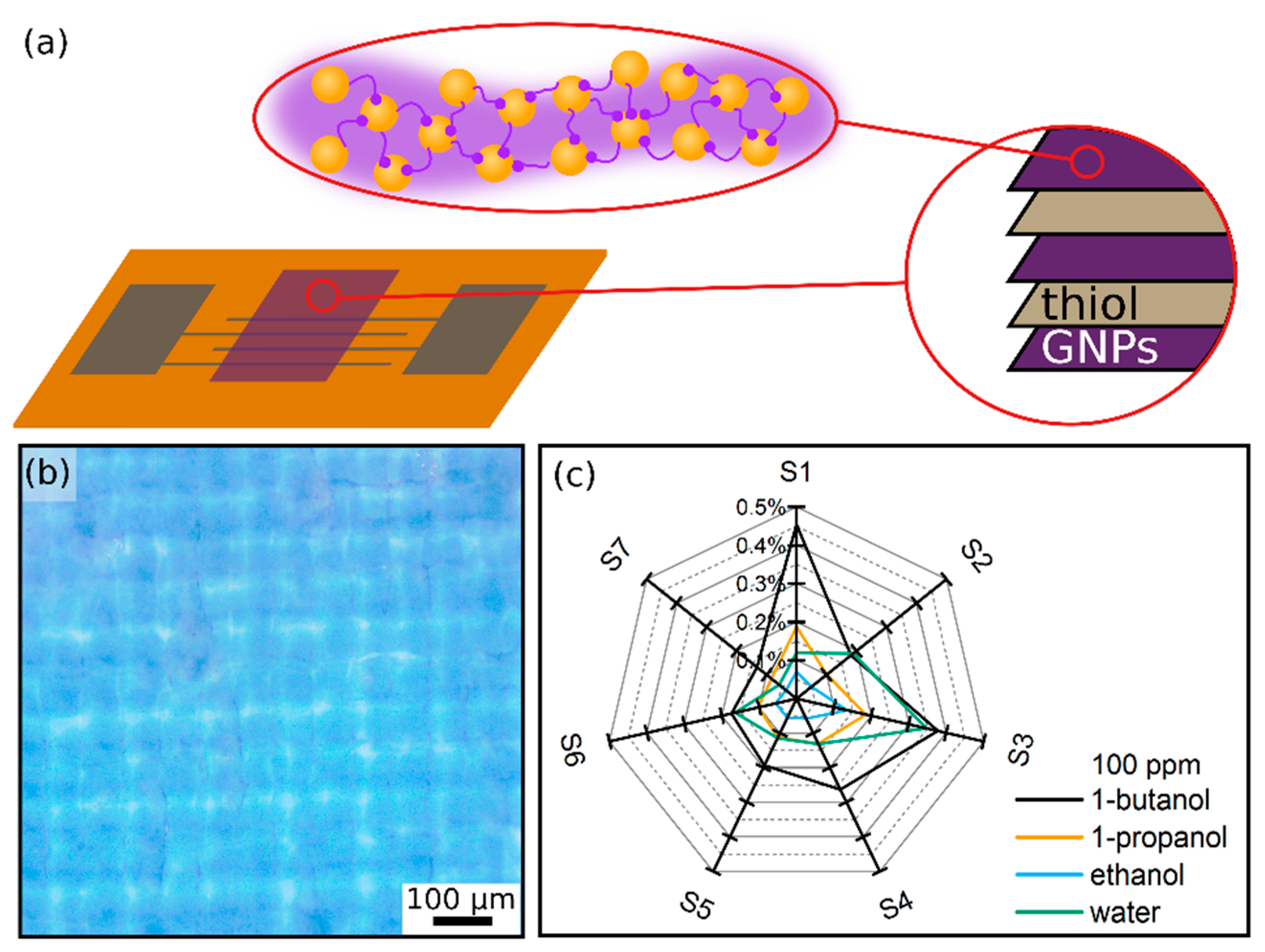Fully Printed Flexible Chemiresistors with Tunable Selectivity Based on Gold Nanoparticle Composites †
References
- Liao, Y.; Zhanga, R.; Qian, J. Printed electronics based on inorganic conductive nanomaterials and their applications in intelligent food packaging. RSC Adv. 2019, 9, 29154–29172. [Google Scholar] [CrossRef] [PubMed]
- Su, C.-H.; Chiu, H.-L.; Chen, Y.-C.; Yesilmen, M.; Schulz, F.; Ketelsen, B.; Vossmeyer, T.; Liao, Y.-C. Highly Responsive PEG/Gold Nanoparticle Thin-Film Humidity Sensor via Inkjet Printing Technology. Langmuir 2019, 35, 3256–3264. [Google Scholar] [CrossRef] [PubMed]
- Yao, S.; Swetha, P.; Zhu, Y. Nanomaterial-Enabled Wearable Sensors for Healthcare. Adv. Healthc. Mater. 2018, 7, 1700889. [Google Scholar] [CrossRef] [PubMed]
- Broza, Y.Y.; Zhou, X.; Yuan, M.; Qu, D.; Zheng, Y.; Vishinkin, R.; Khatib, M.; Wu, W.; Haick, H. Disease Detection with Molecular Biomarkers: From Chemistry of Body Fluids to Nature-Inspired Chemical Sensors. Chem. Rev. 2019, 119, 11761–11817. [Google Scholar] [CrossRef] [PubMed]
- Ibañez, F.J.; Zamborini, F.P. Chemiresistive Sensing with Chemically Modified Metal and Alloy Nanoparticles. Small 2012, 8, 174–202. [Google Scholar] [CrossRef] [PubMed]

Publisher’s Note: MDPI stays neutral with regard to jurisdictional claims in published maps and institutional affiliations. |
© 2020 by the authors. Licensee MDPI, Basel, Switzerland. This article is an open access article distributed under the terms and conditions of the Creative Commons Attribution (CC BY) license (https://creativecommons.org/licenses/by/4.0/).
Share and Cite
Ketelsen, B.; Tjarks, P.P.; Liao, Y.-C.; Vossmeyer, T. Fully Printed Flexible Chemiresistors with Tunable Selectivity Based on Gold Nanoparticle Composites. Proceedings 2020, 56, 15. https://doi.org/10.3390/proceedings2020056015
Ketelsen B, Tjarks PP, Liao Y-C, Vossmeyer T. Fully Printed Flexible Chemiresistors with Tunable Selectivity Based on Gold Nanoparticle Composites. Proceedings. 2020; 56(1):15. https://doi.org/10.3390/proceedings2020056015
Chicago/Turabian StyleKetelsen, Bendix, Patrick P. Tjarks, Ying-Chih Liao, and Tobias Vossmeyer. 2020. "Fully Printed Flexible Chemiresistors with Tunable Selectivity Based on Gold Nanoparticle Composites" Proceedings 56, no. 1: 15. https://doi.org/10.3390/proceedings2020056015
APA StyleKetelsen, B., Tjarks, P. P., Liao, Y.-C., & Vossmeyer, T. (2020). Fully Printed Flexible Chemiresistors with Tunable Selectivity Based on Gold Nanoparticle Composites. Proceedings, 56(1), 15. https://doi.org/10.3390/proceedings2020056015



